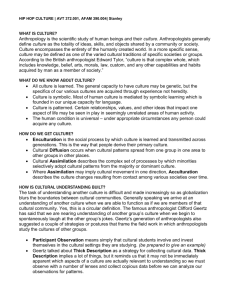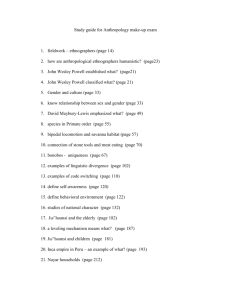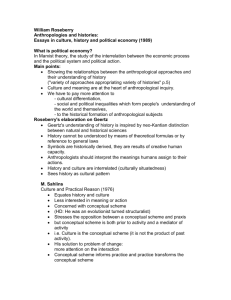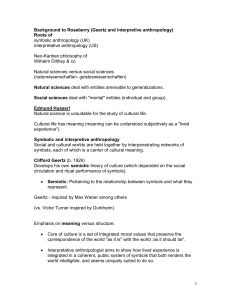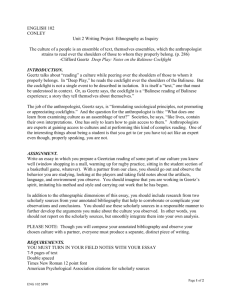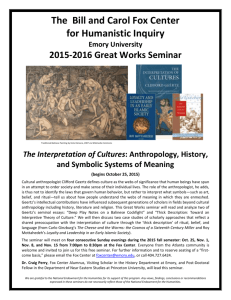Introduction to Cultural Anthropology -- Potential Questions -
advertisement
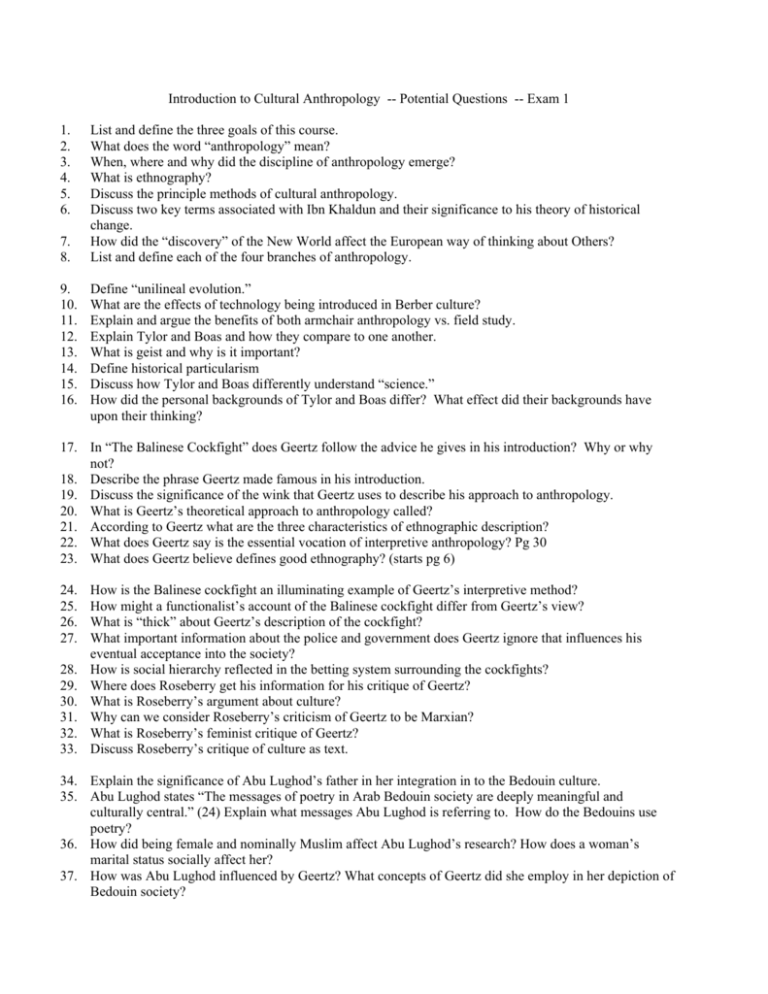
Introduction to Cultural Anthropology -- Potential Questions -- Exam 1 1. 2. 3. 4. 5. 6. 7. 8. 9. 10. 11. 12. 13. 14. 15. 16. List and define the three goals of this course. What does the word “anthropology” mean? When, where and why did the discipline of anthropology emerge? What is ethnography? Discuss the principle methods of cultural anthropology. Discuss two key terms associated with Ibn Khaldun and their significance to his theory of historical change. How did the “discovery” of the New World affect the European way of thinking about Others? List and define each of the four branches of anthropology. Define “unilineal evolution.” What are the effects of technology being introduced in Berber culture? Explain and argue the benefits of both armchair anthropology vs. field study. Explain Tylor and Boas and how they compare to one another. What is geist and why is it important? Define historical particularism Discuss how Tylor and Boas differently understand “science.” How did the personal backgrounds of Tylor and Boas differ? What effect did their backgrounds have upon their thinking? 17. In “The Balinese Cockfight” does Geertz follow the advice he gives in his introduction? Why or why not? 18. Describe the phrase Geertz made famous in his introduction. 19. Discuss the significance of the wink that Geertz uses to describe his approach to anthropology. 20. What is Geertz’s theoretical approach to anthropology called? 21. According to Geertz what are the three characteristics of ethnographic description? 22. What does Geertz say is the essential vocation of interpretive anthropology? Pg 30 23. What does Geertz believe defines good ethnography? (starts pg 6) 24. 25. 26. 27. 28. 29. 30. 31. 32. 33. How is the Balinese cockfight an illuminating example of Geertz’s interpretive method? How might a functionalist’s account of the Balinese cockfight differ from Geertz’s view? What is “thick” about Geertz’s description of the cockfight? What important information about the police and government does Geertz ignore that influences his eventual acceptance into the society? How is social hierarchy reflected in the betting system surrounding the cockfights? Where does Roseberry get his information for his critique of Geertz? What is Roseberry’s argument about culture? Why can we consider Roseberry’s criticism of Geertz to be Marxian? What is Roseberry’s feminist critique of Geertz? Discuss Roseberry’s critique of culture as text. 34. Explain the significance of Abu Lughod’s father in her integration in to the Bedouin culture. 35. Abu Lughod states “The messages of poetry in Arab Bedouin society are deeply meaningful and culturally central.” (24) Explain what messages Abu Lughod is referring to. How do the Bedouins use poetry? 36. How did being female and nominally Muslim affect Abu Lughod’s research? How does a woman’s marital status socially affect her? 37. How was Abu Lughod influenced by Geertz? What concepts of Geertz did she employ in her depiction of Bedouin society? 38. What does Ortner mean by the term “serious games?” What does she mean by “serious” and how does it relate to Himalayan mountaineering as a “dream and a practice?” (23) 39. Explain the relationship between Sherpas and sahibs using the concept of Orientalism. 40. Socially speaking, how does mountaineering reflect the class composition of the Sherpa society? How does the sport “remake” the Sherpa society in terms of their own agenda? 41. Why has the Sherpa culture has drawn personal critique from anthropologists? 42. 43. 44. 45. 46. 47. 48. 49. Who owns the meat of killed animals and how is it distributed? What does insulting the meat mean and how does it contribute to egalitarianism? Which social structure puts the least amount of energy into the ground? What techniques do the hunters use? How would functionalists explain the link between obesity and hunter gatherers? How are the roles of hunter gatherers divided amongst the sexes? Describe the differences between horticultural and agricultural modes of production. What food source most readily available and consumed by the people? 50. 51. 52. 53. 54. 55. 56. 57. 58. Explain Chagnon’s sociobiological analysis of Yanomamo politics. Why is Chagnon’s sociobiological perspective offensive to cultural anthropologists? How does the prospect of political power affect the social structure of Yanomamo society? How is the overall argument/structure of Chagnon's argument functionalist? Why do the Yanomamo consider Chagnon to be “fierce?” How are Yanomamo disputes resolved? Where do the Yanomamo live? Why is the distinction between cross and parallel cousins important to the Yanomamo? Discuss the personal and professional reasons that Chagnon has been considered controversial. 59. Explain Gell's argument of the Muria Gonds from a structural functionalist perspective. 60. Explain the idea of a collectivist attitude and how it relates to the Muria Gond cultural identity. 61. How is the Muria Gond view of commodities different than ours, and what about their culture might account for this? 62. How did the change in the Indian government allow the Muria Gonds to become wealthy? 63. What is the essential problem that Muria Gonds have with wealth? 64. Did the television Gell discusses at the beginning of his article “work” or not? Explain your answer. 65. 66. 67. 68. 69. 70. 71. 72. 73. 74. Describe how the Maale people make their living. Why is labor the most important “productive power” in Maale society? In the Maale society, what is analogous to capital in our society and who owns it? What is the logic of giving crops to the Maale chiefs? Discuss Marx’s notion of “alienation?” How is the notion of “alienation” related to “species being?” What does Marx believe to be the difference between means of production vs. mode of production? For Marx, what is the foundation of any society? What do Marxists mean by “creative social labor” and why is it essential to being human? List the three main productive inequalities among the Maale society. 75. What is “the name relationship” and its significance to the Ju/hoansi? 76. What is one principle that causes short term and or long term changes for the Ju/hoansi? 77. What is the basis of Ju/hoansi kinship and what are the three other types of kinship that they apply within their society? 78. How are relationships of joking and avoidance determined? 79. What is more important- a genealogical tie or the name relationship? 80. How is a Ju/hoansi camp made up? Who is a part of it? What roles do they play? How many members are there? 81. What is the main basis for status distinction for the Ju/hoansi? 82. What is one privilege regarding kinship relations? 83. In what way can the Ju/hoansi be considered a simple society? A complex one? 84. Define functionalism, structural functionalism, structuralism, and interpretivism. Give an example of each from the readings. 85. What is the essential Marxian critique of structural functionalism? 86. How do structuralists and interpretivists differently use “language” as a metaphor for culture? 87. How do anthropologists distinguish between bands, tribes, chiefdoms and states? 88. How do “energy budgets” (the amount expended on production v. the amount returned for consumption) change from bands to contemporary industrial state societies? 89. My parents, Nancy and Jim, gave birth to my brother Eric and myself. My father remarried Laurie and he and Laurie had Jamaica and Nathalie. My mother remarried Jim, who had four boys and two girls from his first marriage to Mary. Draw my family’s kinship chart. 90. What distinguishes Hawaiian kinship terminology? 91. What distinguishes Iroquois kinship terminology? 92. What distinguishes Crow kinship terminology. 93. What is a “descent group?” 94. In kinship, what is “ego?” 95. In the chart below, shade in a matrilineage. 96. In the chart below, shade in a patrilineage. 97. In the chart below, draw in and count the parallel cousins in the youngest generation. 98. In the chart below, draw in and count the cross cousins in the youngest generation. 99. In the chart below, make as many people as possible part of the same patrilineage by adding a single line. 100. In the chart below, make as many people as possible part of the same matrilineage by adding a single line. 101. In the chart below, make the grandfather on the left the brother of the grandmother on the right. What relationships have changed and how? Note: I am including two charts so you can print them out and practice.
